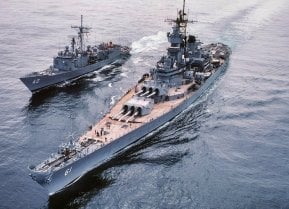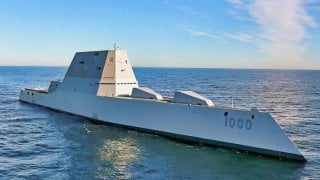Why Doesn't the Navy Build New Battleships? Let the Debate Begin
The concept of a modern battleship frequently surfaces in military discussions, drawing on historical examples like the proposed conversions of the USS Kentucky (BB-66). Originally part of the Iowa-class, this unfinished battleship was considered for transformation into a guided-missile ship during the 1950s, integrating advanced missile technology with traditional naval firepower.
Summary: The concept of a modern battleship frequently surfaces in military discussions, drawing on historical examples like the proposed conversions of the USS Kentucky (BB-66). Originally part of the Iowa-class, this unfinished battleship was considered for transformation into a guided-missile ship during the 1950s, integrating advanced missile technology with traditional naval firepower.

-Despite several ambitious plans, including arming it with ballistic and surface-to-air missiles, the projects were ultimately deemed too costly and were abandoned in favor of developing smaller, more versatile warships like the Boston-class guided-missile cruisers. Today, the notion of large battleships is considered outdated.
-Modern naval strategy favors smaller, agile vessels equipped with advanced weaponry such as missiles and lasers, and potentially augmented by semi-autonomous and unmanned systems. These contemporary "battleships" would bear little resemblance to their massive, heavily armored predecessors, reflecting a shift towards more sustainable, cost-effective naval force structures.
What Would a 21st Century Battleship Look Like? Smaller and Smarter
To naval history buffs, there is something romantic and captivating about the Age of Sail – or the era of wooden ships and iron men. Beginning in 1571 with the Battle of Lepanto, the decisive naval clash between the Roman Catholic Holy League and the Muslim Ottoman Empire, it involved at least 490 warships, mostly galleys, and some 144,000 men.
That age ended in March 1862 with a much smaller engagement, which saw just two "ironclad" warships slug it out at Hampton Roads during the American Civil War. Neither the USS Monitor nor CSS Virginia emerged as a conclusive victory, but the battle was a portent of the Age of the Battleship.
Just as the warships of the Age of Sail continue to captivate those history buffs, so too does the idea of the massive battleships. But just like the ships of the line, the battleship has sailed off into history – and we shall not look upon their like again.
A 21st-Century Battleship – What Could it Be?
On Quora, Reddit, and other social communities, the question of a 21st-century battleship tends to come up all too often – and often the USS Kentucky (BB-66) is used as a point of reference. The unfinished Iowa-class battleship served as a parts hulk, but in January 1950 the incomplete hull was finally launched to make the building dock available for other uses.
Several schemes were considered, including completing the USS Kentucky as a guided-missile ship. Advances in guided missile technology had led to the proposal to create a large warship that could be armed with both traditional guns and missiles. USS Kentucky was seen by the U.S. Navy as a way to bridge the old with the new.

However, the proposal was relatively conservative and would have included the installation of a pair of twin arm launchers for the RIM-2 Terrier surface-to-air missile (SAM) on the aft deckhouse, while a pair of antennas for the associated AN/APG-55 pulse-Doppler interception radar would have been installed forward of the missiles, while AN/SPS-2B air search radar would have also been installed.
As USS Kentucky was already about three-quarters completed, with construction halted at the main deck, it was expected that installation of the missile system and associated electronics would have only involved adding the necessary equipment without a need to rebuild the ship to accommodate this adaptation. The guided-missile project was actually authorized in 1954, and USS Kentucky was subsequently redesignated and renumbered accordingly from BB-61 to BBG-1. The conversion was due to be completed in 1956 – but it wasn't to be. The project was canceled and many of the conversion ideas were transferred to a smaller platform.
That resulted in the development of the Boston-class guided-missile cruiser.
A second conversion project with the USS Kentucky was considered in early 1956 that could have seen the warship fitted with two Polaris ballistic missile launchers with a capacity for sixteen weapons. USS Kentucky would have also been equipped with four RIM-8 Talos SAM launchers with a total of eighty missiles per launcher; and twelve FIM-24 Tartar SAM launchers with 504 missiles. A July 1956 estimate conducted by the U.S. Navy estimated that the project upgrades could be completed by July 1961. Yet again it wasn't to be. The costs of the conversion forced the service to abandon the project.
More importantly, the answer to the question of the need for such a large capital ship was made clear – apart from aircraft carriers, smaller warships were the future. Simply put, there is no reason for any navy to build big gun battleships as smaller guided-missile cruisers and guided-missile destroyers can do the same job.
New Battleships for the U.S. Navy: Large Unnecessary Targets?
Though it is true that no American battleships were sunk after Pearl Harbor, two dozen of the capital warships were sent to the bottom of the ocean during the Second World War – including such famous vessels as Germany's Bismarck, the Royal Navy's HMS Prince of Wales, and the Japanese battleship Yamato.

With both the Bismarck and Yamato there was a tremendous loss of life – notably the trained sailors that simply couldn't be replaced by either nation.
Though the United States Navy briefly brought back the Iowa-class battleships at the end of the Cold War, the vessels proved ill-suited to the demands of the late 20th century. It is apparent to naval planners today that the large battleships are from a bygone era and aren't likely to make a return again, as smaller warships can pack the same punch, move faster, and put fewer sailors at risk.
Any 21st century "battleship" will thus be a much smaller semi-autonomous vessel, operated remotely, armed with missiles and lasers, and supported by naval and aerial drones. It would be as different from the battleships of World War II as those warships were from the vessels that fought at Lepanto more than 450 years ago.
Author Experience and Expertise: Peter Suciu
Peter Suciu is a Michigan-based writer. He has contributed to more than four dozen magazines, newspapers, and websites with over 3,200 published pieces over a twenty-year career in journalism. He regularly writes about military hardware, firearms history, cybersecurity, politics, and international affairs. Peter is also a Contributing Writer for Forbes and Clearance Jobs. You can follow him on Twitter: @PeterSuciu. You can email the author: [email protected].
All images are Creative Commons.


